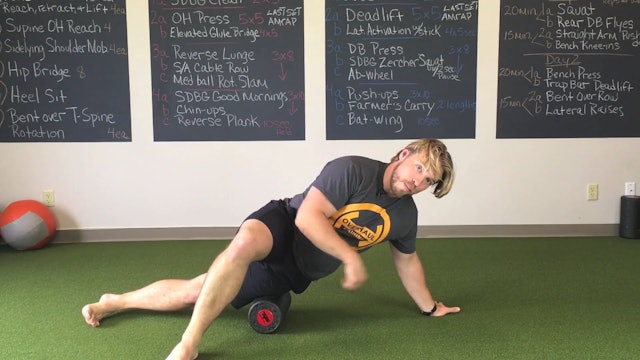Total Strength Month #1
3 Seasons
Once you've passed the Overhaul Protocol Challenge https://overhaultraining.vhx.tv/start-here-2 , this series of monthly programs is what I suggest you use as the core of your training. It's a 2x/week program and depending on your goals and time available, you can select additional training days from Muscle Up!, Shred It! and Recover & Realign.
TRAINING SCHEDULE AND FREQUENCY
Each week you will perform the A and B-Day programs once, beginning each session with the same warm-up. If you have time and energy, you can add a Shred It! https://overhaultraining.vhx.tv/shred-it-2 or Muscle Up! https://overhaultraining.vhx.tv/muscle-up as well.
WHAT THINGS MEAN ON YOUR TRAINING LOG
Let’s look at your A-Day sheet for an example. You'll find the training log PDFs in the warm-up section.
4a, b and c are what we call a super-set.
That means you perform a set of each consecutively before repeating the first exercise again.
The column to the right indicates how many sets and reps you’ll perform of each exercise.
This part of your training session goes like this…
Perform 10 sumo deadlifts, immediately do 10 repetitions of the single arm dumbbell row on each arm, followed by 10 supine cross toe touches per side. This is your first super-set. Rest a minute, sip your water and perform that two more times before moving on to your next super-set.
NOTE:
If you've done Overhaul Protocol you'll be familiar with much of the program structure in Total Strength except for two key features...
-SETS, REPS & LOADS FOR MAIN LIFTS- (deadlift, squat, overhead press, bench press) Some people tend to choose weights that are far too light to build strength while others go too heavy too quickly, risking injury and over-training.
In order to find the sweet spot of safely developing strength, you will be following a set system for choosing the weight for each of your sets. This is done in 2 steps...
Step 1) Determine your current training max.
Your training max is the top weight that you can lift in an exercise for 5 repetitions OR 90% of the weight you can lift for 1 repetition.
If you know your 5 rep max, great! Move on to step 2.
You can also use the table below to find an equivalent of another rep max you may know.
Rep Max Percentage Table (Training Max =90%)
2-3 reps = 95%
4-5 reps = 90%
6-7 reps = 85%
8-9 reps = 80%
10-11 reps = 75%
12-13 reps = 70%
14-15 reps = 65%
If you’re getting more than 15 reps with your heaviest weight, you’ll need to get back in there and put more weight on the bar.
If you have no idea what kind of weight and reps you can do for a main lift then either take a day and go experiment, or figure it out as you go.
Step 2) Determine the weights for all your sets for the month.
Every set is a percentage of your training max.
For Example: If your training max was 90 lbs. you would multiply it by .4 to find the weight for Set 1, giving you 36 lbs. I also then round up or down unless you have fractional plates.
Set 1= 35 lbs. (40%) x 5 reps
Set 2= 45 lbs. (50%) x 5 reps
Set 3= 55 lbs. (60%) x 5 reps
Every week you will do the same weight for your first 3 sets but the weight and number of reps changes for sets 4, 5, 6.
AMRAP = As Many Reps As Possible (with perfect form)
Week 4 DELOAD = Only do the first 3 sets during a deload week. It should feel super easy. This is to give your nervous system a rest so you don't over-train and burnout. It's also a good idea to not push yourself super heavy on other exercises this week too.
Add 5 lbs. each month to your training max for the bench press and overhead press. 10 lbs. for the squat and deadlift.
-FINISHERS-
The last super-set of each training session is what we call a Finisher. These are intense, short bursts of cardiovascular work to finish you off. We generally do 2 or 3 rounds of the finisher depending on how you feel. Some of them will require equipment that not all gyms have. For this reason I will have a growing library of finisher exercises that you can choose from as substitutions.
CHOOSING WEIGHTS FOR OTHER EXERCISES
Choosing the appropriate weights for each exercise is more art than science, at least for beginners or when you’re de-conditioned. You don’t truly know your upper limits yet because they haven’t been sufficiently tested.
So how do you choose your weights? First, keep these three objectives in mind:
1) Begin with a modest weight and master the quality of the movement.
2) When you can control the movement beautifully, slowly and steadily increase the weight.
3) Never go heavier or do more reps than you can perform with good form.
And what keeping good form really means is not exceeding your current ability to stabilize and protect your joints and ligaments.
Safety is always priority but you need to challenge yourself by increasing the weights. Heavier weights give you stronger, more injury resistant bones and connective tissue. Training to maintain good form with heavier loads means being able to live a more vigorous life without fear of getting hurt.
What this usually looks like…
Generally, your first set will feel easy, your middle set(s) will be getting heavier and your last set should feel kinda heavy.
In truth, the first week you will simply experiment with different weights to find the sweet spot of just challenging enough. Feel free to make a note for yourself if your last weight for an exercise was too easy or too hard.
Each week after that try to make your first and last sets a little heavier than you did the week before, but never compromise good form.
-
 00:57Episode 1
00:57Episode 1Total Strength Intro
Episode 1
-
 02:53Episode 2
02:53Episode 2General Foam Rolling
Episode 2
You can purchase a firm foam roller at most local sporting good stores or through Amazon.com. http://amzn.to/2pjYDjK
If you'd like to start with a softer one, try this http://amzn.to/2q2Dmv2
-
 01:04Episode 3
01:04Episode 3Super(wo)man Drill
Episode 3
-
 00:29Episode 4
00:29Episode 4Supine Overhead Reach with Ab Crunch
Episode 4
-
 00:27Episode 5
00:27Episode 53 Point Thoracic Spine Mobilization
Episode 5
-
 00:52Episode 6
00:52Episode 6Dynamic Adductor Stretch
Episode 6
-
 01:42Episode 7
01:42Episode 7Hip Mobility Drill
Episode 7
-
 02:50Episode 8
02:50Episode 8Static Shoulder Pack
Episode 8


